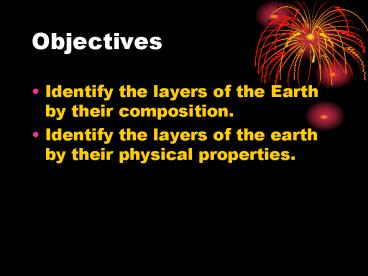Objectives - PowerPoint PPT Presentation
1 / 20
Title:
Objectives
Description:
Pieces of the lithosphere that move around on top of the asthenosphere are ... The lithosphere is like a jigsaw puzzle, and the tectonic plates are the pieces ... – PowerPoint PPT presentation
Number of Views:19
Avg rating:3.0/5.0
Title: Objectives
1
Objectives
- Identify the layers of the Earth by their
composition. - Identify the layers of the earth by their
physical properties.
2
Vocabulary
- Crust
- Mantle
- Core
- Lithosphere
- Asthenosphere
- Mesosphere
- Tectonic plates
3
The composition of the Earth
- The earth is divided into 3 layers based on the
compounds that make up each layer the crust,
the mantle and the core.
4
(No Transcript)
5
- The outermost layer of the earth is the crust.
- The crust is 5 to 100 km thick.
- It is the thinnest layer of the earth.
- There are two types of crusts continental and
oceanic.
6
- Both continental and oceanic crust are made
mainly of the elements oxygen, silicon and
aluminium.
7
- The mantle
- The layer of the earth between the crust and the
core is the mantle. - Because the mantle has more magnesium and less
aluminium than the crust does, the - mantle is denser
- than the crust.
8
- The core
- The layer of the earth that extends from below
the mantle to the center of the earth is the
core. - Scientists think that the earths core is made
mostly of iron and contains smaller amounts of
nickel, but almost no oxygen, silicon, aluminium
or magnesium
9
The physical structure of the Earth
- The earth is divided into 5 physical layers the
lithosphere, asthenosphere, mesosphere, outer
core and inner core
10
(No Transcript)
11
(No Transcript)
12
Tectonic Plates
- Pieces of the lithosphere that move around on top
of the asthenosphere are called tectonic plates. - All of the tectonic plates have names.
13
- The lithosphere is like a jigsaw puzzle, and the
tectonic plates are the pieces of the jigsaw
puzzle.
14
- The thickest part of the South American plate is
the continental crust. The thinnest part of this
plate is the mid-atlantic ocean.
15
- Think about ice cube floating in a bowl of punch.
If there are enough cubes, they will cover the
surface of the punch and bump into one another. - Parts of the ice cubes are below the surface of
the punch and displace the punch. - Large pieces of ice displace more punch than
small pieces of ice. - Tectonic plates float on the asthenosphere in a
similar way. - The plates cover the surface of the asthenosphere
and they touch one another and move around. - Thick tectonic plates, such as those made of
continental crust, displace more asthenosphere
than do thin plates, such as those made of
oceanic lithosphere.
16
- Q? Why do tectonic plates made of continental
lithosphere displace more asthenosphere than
tectonic plates made of oceanic lithosphere do? - A Although continental lithosphere is less dense
than oceanic lithosphere is, continental
lithosphere has a greater mass because of its
greater thickness and will displace more
asthenosphere than oceanic lithosphere
17
- How do scientists know things about the deepest
parts of earth where no one has ever been?
Scientists have never even drilled through the
crust. - Some of the answers come from earthquakes.
- When an earthquake happens, vibrations called
seismic waves are produced. - Seismic waves travel at different speeds through
the earth. - Their speed depends on the density and
composition of material that they pass through. - For example a seismic wave traveling through a
solid will go faster than a seismic wave
traveling through a liquid.
18
- When an earthquake happens, machines called
seismographs measure the times at which seismic
waves arrive at different distances from an
earthquake. - Seismologists can then use these distances and
travel times to calculate the density and
thickness of each physical layer of the earth.
19
(No Transcript)
20
(No Transcript)































